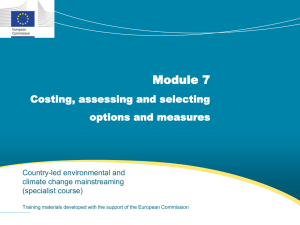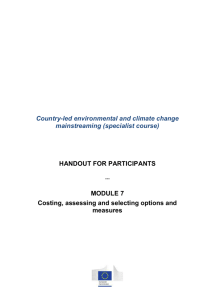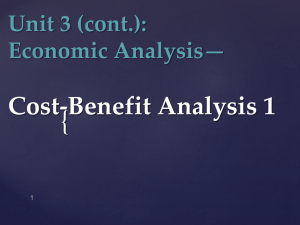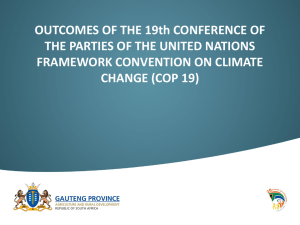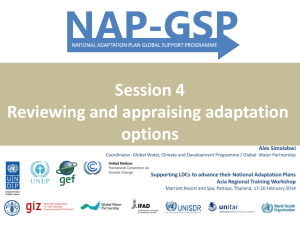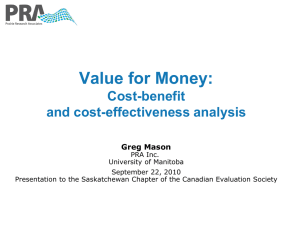Module 5 - Cost - Global Climate Change Alliance
advertisement
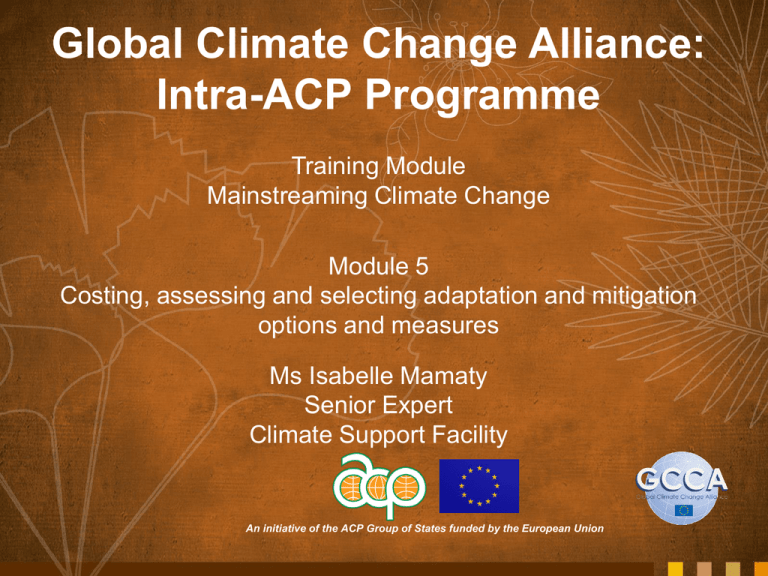
Global Climate Change Alliance: Intra-ACP Programme Training Module Mainstreaming Climate Change Module 5 Costing, assessing and selecting adaptation and mitigation options and measures Ms Isabelle Mamaty Senior Expert Climate Support Facility An initiative of the ACP Group of States funded by the European Union Costing, assessing and selecting adaptation and mitigation options Learning objectives: o To understand how to assess and select adaptation and mitigation options o To ensure that projects address development needs Expected outcomes: o Increased knowledge on tools for costing and assessing adaptation and mitigation options o Increased knowledge on tools for prioritising and selecting adaptation and mitigation options 2 Linking policy, costing and budgeting Mainstreaming of climate change in policies, strategies & programmes Identification of adaption and mitigation options Costing, assessment and selection of adaptation and mitigation options Resource allocation: Integration of adaptation and mitigation measures in budgets 3 Tools for costing and assessing adaptation and mitigation options 4 Cost-benefit analysis: identifying costs and benefits Adaptation Costs: extra costs incurred compared with the ‘business-asusual’ scenario Benefits: avoided damage and losses, extra developmental benefits compared with ‘business-as-usual’ scenario Mitigation Costs: extra costs incurred compared with ‘business-asusual’ scenario, reduced economic growth opportunities Benefits: cost savings, sales of carbon credits, positive environmental and related health/livelihoods outcomes (+ difficult to value: strategic and competitive advantages) 5 Can you think of some examples? Cost-benefit analysis (1) Cost-benefit analysis (CBA): o Quantifies all the costs and benefits (*) of an intervention (with benefits including both ‘positive’ benefits and avoided losses) over the entire lifetime of the intervention o A ‘discount rate’ is applied to all costs and benefits to represent ‘preference for the present’ or simply the opportunity cost of capital -> calculation of ‘present value’ • The higher the discount rate, the smaller the present value • The further away in the future, the smaller the present value • Significant controversies over the ‘right’ discount rate for assessing long-term options (*) Actually the ‘incremental’ costs and benefits, i.e. the difference in costs/benefits between a ‘with intervention’ and a ‘no intervention’ scenario 6 Cost-benefit analysis (2) Outputs of cost-benefit analysis: Cost-benefit ratio (CBR) Net present value (NPV) Internal rate of return (IRR) Ratio of costs to benefits calculated at their present value (the smaller, the better – should be <1) Benefits minus costs calculated at their present value (the larger, the better) The discount rate at which NPV = 0 A measure of the ‘benefit-generating power’ of the option or intervention (the larger, the better) 7 Cost-effectiveness analysis (1) Cost-effectiveness analysis (CEA): o Costs are valued in monetary terms, and benefits (*) quantified in ‘physical’ units, over the entire lifetime of the intervention; a discount rate is applied to both o This allows calculating unit costs, as the ratio of total discounted costs to total discounted benefits obtained o The obtained unit costs support : • the comparison of several options • comparison with ‘benchmark costs’ for similar interventions, where available (*) As in cost-benefit analysis, ‘incremental’ rather than absolute costs and benefits should be taken into account 8 Cost-effectiveness analysis (2) Compared with CBA, CEA: o is suitable where it is difficult to assign a monetary value to benefits o but requires identifying a single, allencompassing measure of benefits – which may be both difficult and reductive 9 Illustration of CEA: Global GHG abatement cost curve Source: McKinsey (2009), Exhibit 8, p. 17 10 Example: land-based mitigation options Significant mitigation potential for developing countries Atmosphere CO2 CH4 N2O CO2 Forests Peatlands Grasslands Net sink (tree biomass + soil organic matter) Largest & most efficient terrestrial store of carbon biomass Net carbon sink if not degraded Improved ecosystem management also supports adaptation 11 Typically costeffective and requiring low upfront investment Cultivated systems Both a sink and a source of GHGs, net balance depends on cultivation methods Financial and economic analysis Both CBA and CEA support: Basis for private sector decision making o financial analysis: considers the ‘monetary’ costs and benefits (or equivalent) accruing to parties directly concerned by a project or programme, at their ‘face value’ o economic analysis: broadens the analysis to more accurately reflect costs and benefits to society Basis for public sector decision making 12 Complementary tools For the assessment of robustness and the integration of uncertainty, CBA/CEA can be combined with: o the use of multiple scenarios (e.g. ‘no change’ scenario and various climate change and development scenarios) o sensitivity analysis (i.e. testing of the effect of changes in scenario assumptions on the CBR, NPV, IRR or unit costs) o risk analysis (-> risk probability analysis includes the probability of occurrence of various cost and benefit outcomes in calculations... assuming probabilities are known) 13 Tools for prioritising and selecting adaptation and mitigation measures 14 Supporting decision making CBA/CEA support the financial and economic assessment of adaptation/mitigation options o They help identify measures that offer the best ‘value for money’ – a key aspect in situations of budgetary constraints Other types of assessment and other criteria (e.g. technical, social, environmental) are required to fully inform decision makers Multi-criteria analysis (MCA) helps integrate various criteria Multi-criteria analysis (1) An approach to decision support that uses more than one criterion to assess performance and rank various options or interventions The term actually covers a wide range of methods Typically: o various options or interventions are assessed against a pre-determined set of criteria o qualitative ratings or quantitative scores are given o rules are then applied to rank options/interventions • Numerical scores can be added up to calculate a total score (with the possibility of applying different weights to different criteria) 16 Multi-criteria analysis (2) MCA is a useful complement to CBA/CEA Allows combining financial/economic criteria with technical, environmental and social ones It can be used on its own, or in combination with CBA/CEA: MCA before CBA/CEA Allows reducing the number of options to which CBA/CEA is applied MCA after CBA/CEA CBA/CEA helps eliminate financially or economically unviable options, then MCA allows for final selection based on extra criteria 17 Example of MCA grid Option Effectiveness Cost or CBR (*) Technical feasibility Social & cultural acceptability Environm ental impacts Total score Option 1 Option 2 Option 3 Option 4 Scores: from 1 (poorest performance) to 4 (highest performance). As far as cost is concerned, a scale should be established, with scores corresponding to a given cost range or cost/unit range. (*) CBR = cost-benefit ratio Adapted from USAID (2007), Exhibit 12, p. 18 18 Turning words into action 19 Discussion Questions and answers Costing, assessing and selecting adaptation and mitigation options and measures What are the opportunities for costing, assessing and selecting adaptation and mitigation options and measures in your sector or at your level and what are the institutional and capacity needs in your organisation to do so? 20 Presentation of case studies Presentation of case studies using MCA grid 21 Learning process exercise: Working group Exercise: Preparation of MCA grid for a specific project 22 Recap – Key messages Cost-benefit analysis and cost-effectiveness analysis support the identification of financially and economically viable adaptation and mitigation options/measures o Help prioritise actions based on financial/economic criteria Multi-criteria analysis, used alone or in combination with CBA or CEA, supports the assessment and prioritisation of adaptation and mitigation options based on multiple criteria o Technical, environmental and social criteria can be considered alongside financial/economic ones 23 Key references Economics of Climate Adaptation Working Group (2009) Shaping climate-resilient development: a framework for decision-making. Climate Works Foundation, Global Environment Facility, European Commission, McKinsey & Company, The Rockfeller Foundation, Standard Chartered Bank & Swiss Re USAID (2007) Adapting to climate variability and change: a guidance manual for development planning World Bank – Economics of Adaptation to Climate Change web pages: http://climatechange.worldbank.org/content/economicsadaptation-climate-change-study-homepage 24 • Thank you • Contact: Dr. Pendo MARO, ACP Secretariat pendomaro@acp.int or +32 495 281 494 www.gcca.eu/intra-acp 25

